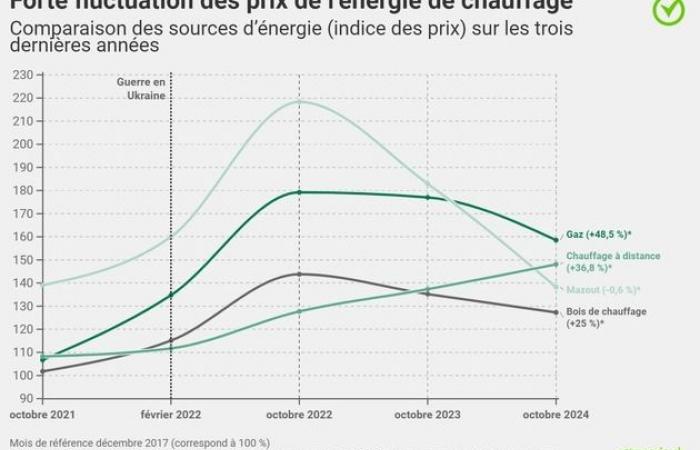26.11.2024 – 00:30
comparis.ch AG
A document
- 20241126_MM_Konsumen~reisindex_3_FRA.pdf
PDF – 639 kB
Press release
Consumer Price Comparison Index November 2024
Comparison of heating prices over three years: sharp increase in gas, wood and district heating, slight decline in fuel oil
According to the Comparis consumer price index, everyday goods in Switzerland increased by 0.1% in October 2024 compared to the same month last year. The prices of heating energy (gas, oil, firewood and district heating) fell significantly during this period, by 14.1%. The differences in the evolution of the prices of energy sources over the last three years are striking: gas (+48.5%*), firewood (+25.0%*) and district heating ( +36.8%*) became significantly more expensive during this period, while fuel oil prices fell by 0.6%*. “With the arrival of the cold season, heating costs are once again at the center of concerns. Conscious use of energy, for example by avoiding heating above 22 degrees, is all the more important given the still high costs,” says Dirk Renkert, Argent Comparis expert.
Zurich, November 26, 2024 – The Comparis Consumer Price Index, established in collaboration with the Center for Economic Research (KOF) at ETH Zurich, measures inflation as it is felt by consumers and businesses. consumers. To do this, only the evolution of the prices of everyday consumer goods is taken into account, for example those of food, medicines or clothing. The inflation rate is thus calculated excluding rents and durable goods.
According to the Comparis consumer price index, everyday goods in Switzerland increased by 0.1% in October 2024 compared to the same month last year. The Swiss consumer price index (CPI) established by the Federal Statistical Office (FSO) shows an increase of 0.6%*.
Since September 2024, the prices of the Swiss Comparis basket have fallen, by precisely 0.3% (CPI: -0.1%*). The previous month, the costs of everyday consumer goods fell by 0.5% (CPI: -0.3%*).
Prices for gas, firewood and district heating have increased significantly, oil prices have fallen
The prices of heating energy (gas, oil, firewood and district heating) have certainly fallen by 14.1% on average compared to the same month of last year. However, they have increased significantly over the past three years, by 24.0% on average. For comparison, the CPI only increased by 5.40%* during this period. After Russia’s attack on Ukraine in February 2022, energy prices skyrocketed and have since fallen, albeit to varying degrees. Among the energy sources which have become particularly expensive over the last three years, we find gas (+48.5%*), firewood (+25.0%*) and district heating (+36 .8%*). On the other hand, the price of fuel oil has fallen particularly significantly and even shows a drop of 0.6%* compared to its level three years ago.
“The lack of Russian gas could be compensated by other suppliers, but only with higher prices. The evolution of gas prices shows the risks of too much dependence on different suppliers. The sharp increase in gas prices is hitting consumers particularly hard, because this energy is around 40% more expensive than fuel oil and wood pellets, which are part of the firewood category,” explains Dirk Renkert, Argent Comparis expert. .
The sharp increase in wood pellet prices results from the increase in demand since 2022 in direct reaction to the takeoff in gas and fuel oil prices. The strength of the franc did not change anything, because around 80% of the supply came from national production, continues D. Renkert.
“With the arrival of the cold season, heating costs are once again at the center of concerns. Conscious use of energy, for example by avoiding heating above 22 degrees, is all the more important given the still high costs,” says the Comparis expert.
Strongest price increase over twelve months
The price of electricity increased by 17.8%* compared to the same month of the previous year. According to Comparis analysis, no other property has experienced such a strong increase over twelve months.
“Consumers can expect an average reduction in their electricity bill of around 10% next year. The stabilization of wholesale purchase prices, the reduction in winter reserve costs and the reduction in network costs have made this reduction possible. Despite this, the price of electricity has increased by 47.9%* over the past two years. Even after the price drop, a large number of consumers will therefore continue to feel the high electricity prices in their wallets,” explains Dirk Renkert.
Sugar prices also increased, by 10.4%*. They thus climb onto the second step of the inflation podium. Prices for postal services (+8.8%*) recorded the third largest increase. The 4th and 5th places are occupied respectively by margarine, edible fats and oils (+7.9%*) as well as fruit and vegetable juices (+6.3%*).
Biggest price drop over twelve months
In addition to the prices of heating energy (gas, oil, firewood and district heating), fuel prices also fell, falling 9.4% below their October 2023 level.
“Fuel prices also benefited from the fall in crude oil prices. Over three years, they have decreased by 0.4%*,” says Dirk Renkert.
The prices of other services for individual transport (-5.9%*), non-electrical devices for personal care (-5.8%*) as well as data carriers and content (-5.2%*) also fell.
Highest inflation for people aged 65 or older living alone
By type of household, those consisting of a person aged 65 or over experienced the highest increase in prices over the last twelve months. The rate of inflation as they feel it compared to last year amounts to 0.4%. However, in October, the cost of living fell by 0.3% compared to the previous month for this category of the population.
If we stick to the figures, among all households, it is couples under 65 without children who, in percentage, feel the increase in costs the least. With an index set at 107.4 points, the inflation felt by people in this category has remained unchanged over the last twelve months.
Households belonging to the lowest income class are the most affected by inflation
Looking at income brackets, we see that compared to last year, it is for the lowest income category that the cost of living has increased the most. Its consumer price index rose 0.3%. In October, inflation stood at -0.3%.
The middle to high income class was not affected at all by the increase in prices. For her, prices have not changed since last year. Last month, they even fell by 0.3%.
Highest inflation in German-speaking and Rhaeto-Roman Switzerland
A comparison of linguistic regions reveals that German-speaking Switzerland and Rhaeto-Romanic Switzerland recorded the highest increase in prices compared to the previous year, namely 0.2%. In October, the price level fell by 0.3% compared to the previous month.
The lowest increase in prices compared to the previous year was recorded in Italian Switzerland, where it amounted to 0.1%. Compared to the previous month, the cost of living fell by 0.4% in October.
* Comparis Consumer Price Index
The Swiss Consumer Price Index (CPI) measures price developments based on a representative basket of around 1,050 goods and services. Inflation is characterized by a persistent decline in monetary value or an increase in the average price level. The CPI has 12 main categories, including long-term investments and rents. On the other hand, major expenditure items, such as social insurance premiums or direct taxes, are not taken into account. The CPI therefore does not reflect inflation as it is actually felt by consumers.
Established in collaboration with the Center for Economic Research (KOF) at ETH Zurich, the Comparis consumer price index reflects the perception of inflation by excluding rent amounts and the prices of durable goods such as cars. tourism and furniture taken into account in the CPI data. In addition, Comparis explicitly takes into account factors such as household type, income category and language region. In addition, a price comparison smoothed over 20 years is carried out and own calculations are carried out for some product groups. Important note: numbers marked with an asterisk
were calculated directly by the Federal Statistical Office (IPC/OFS) or are based on figures from the IPC/OFS.
The data underlying the Comparis consumer price index come from the Swiss Consumer Price Index (CPI) as well as the Household Budget Survey (HBS). The weights for the new price indices are established based on the EBM. The chained Laspeyres indices are then calculated with the CPI price series. The base index is that of December 2017 (corresponds to 100%).
Dirk Renkert Expert Argent Téléphone: 044 360 53 91 E-mail: [email protected] comparis.ch/hypoPlus
To find out more:
About comparis.ch
With more than 80 million visits per year, comparis.ch is one of the most visited websites in Switzerland. The company compares the prices and services of health funds, insurance companies, banks and telecom operators. It also presents the largest online offering in Switzerland for automobiles and real estate. With its detailed comparisons and in-depth analyses, it contributes to more transparency in the market. comparis.ch thus strengthens the expertise of consumers in decision-making. The company was founded in 1996 by economist Richard Eisler. This is a private company. Even today, Comparis is majority owned by its founder. No other company or the State holds any stake in Comparis.
Swiss






